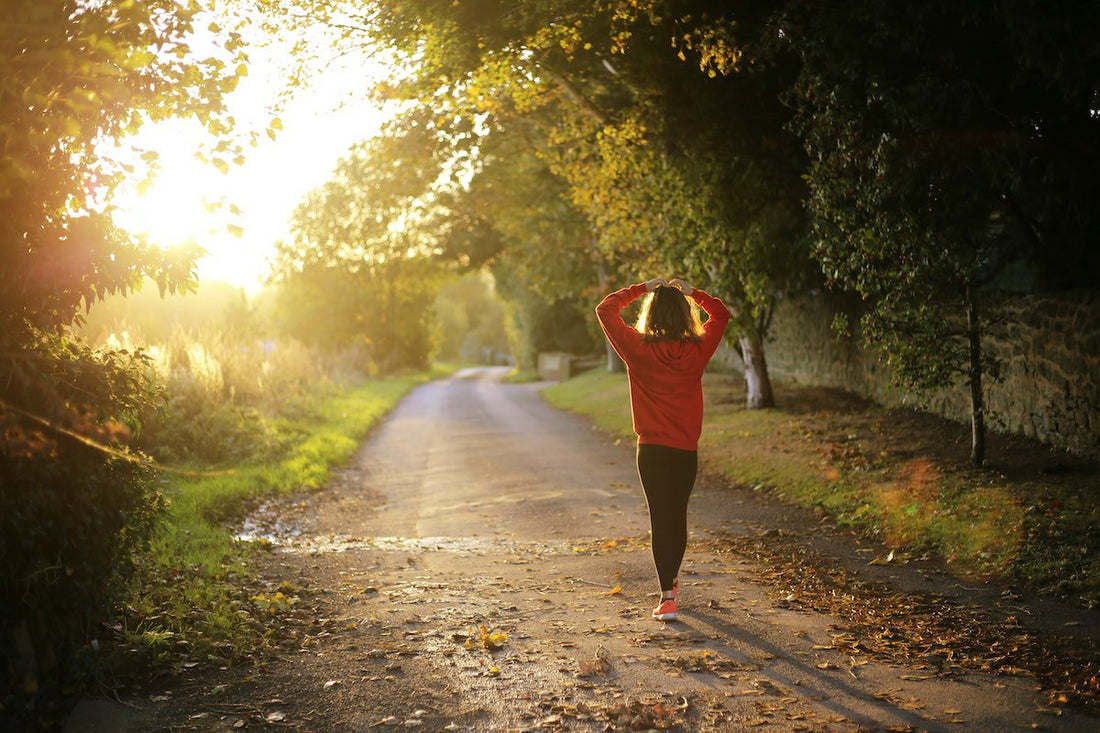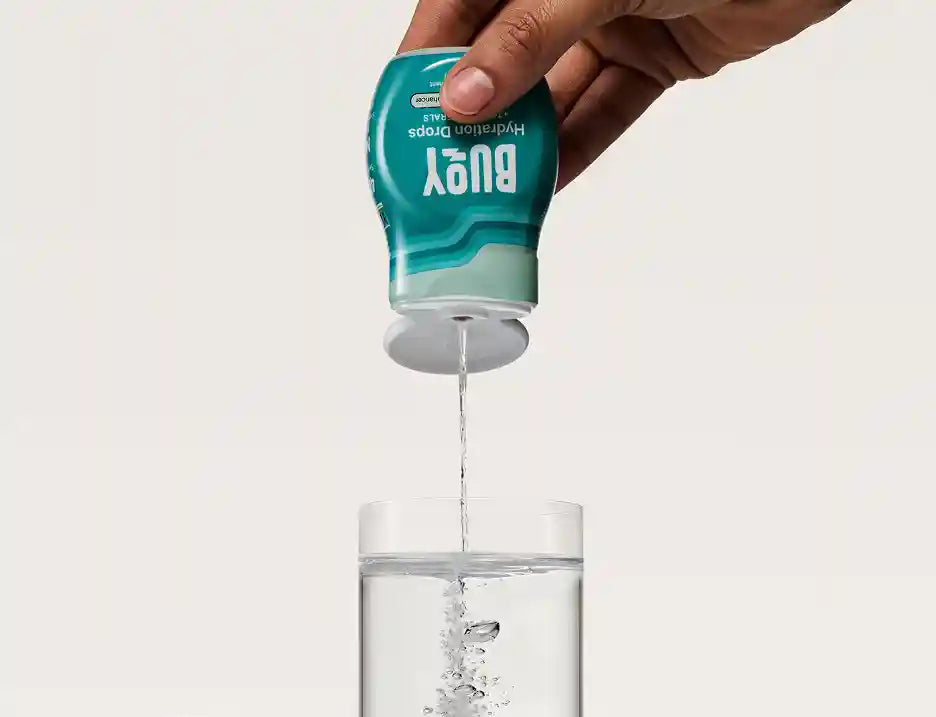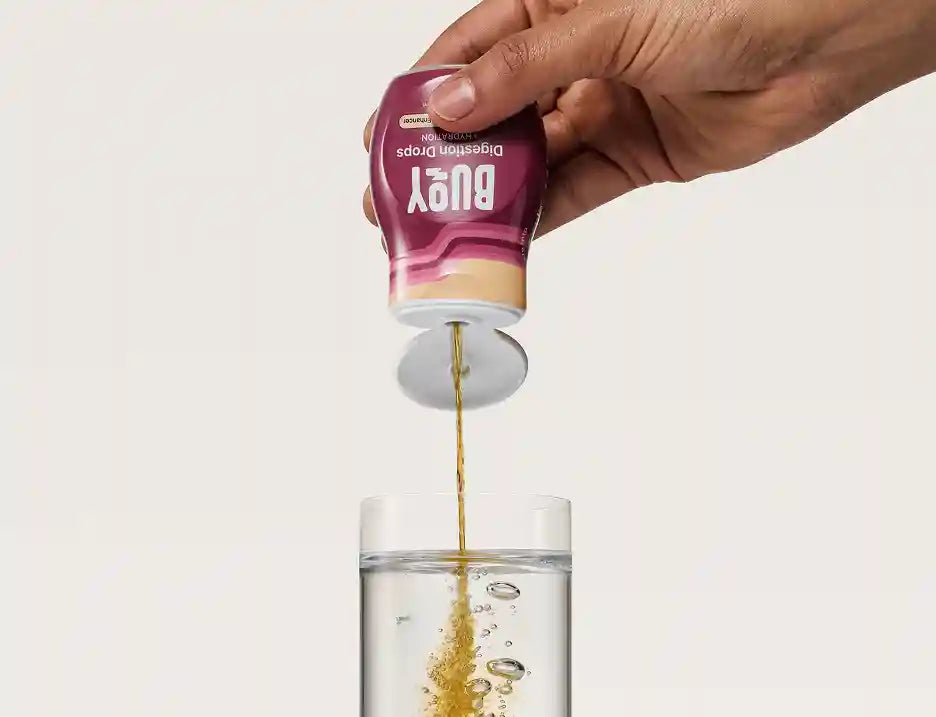
The Link Between Dehydration, Electrolyte Imbalance and Muscle Cramps
Muscle Cramps from Dehydration: Understanding the Cause and Finding Relief
Muscle cramps can hit at any time, whether you're at work, relaxing, or pushing through an intense workout. The most common culprit? Dehydration. When your body lacks fluids and electrolytes, your muscles struggle to function properly, leading to painful spasms.
Essential Takeaways
- Dehydration is a leading cause of muscle cramps. Keeping your hydration and electrolyte levels balanced is key to prevention.
- Restoring lost electrolytes can quickly relieve muscle cramps and help you avoid future occurrences.
- The Daily Wellness Bundle with Buoy Hydration Drops, Energy Drops, and Immunity Drops makes it easy to stay hydrated and maintain electrolyte balance.
If you're tired of dealing with these sudden cramps, this guide will help you understand why they happen and provide practical ways to prevent and relieve them.
- The Connection Between Dehydration and Muscle Cramps
- Immediate Relief: How to Stop Muscle Cramps Quickly
- Rehydration: Your First Line of Defense Against Cramps
- The Best Electrolyte-Rich Foods and Drinks
- Epsom Salt Baths: A Relaxing Way to Ease Cramps
- Long-Term Strategies to Prevent Muscle Cramps
- Staying Hydrated During Exercise: A Must for Cramp Prevention
- Monitoring Your Electrolyte Levels
- When to Seek Medical Attention
- Take Control of Your Hydration and Prevent Muscle Cramps
The Connection Between Dehydration and Muscle Cramps
Muscle cramps caused by dehydration are more common than many realize. While athletes are frequent sufferers, anyone can experience them, from office workers to older adults and people spending time in hot weather.
What Causes Muscle Cramps Due to Dehydration?
When you sweat or fail to drink enough fluids, your body's electrolyte levels drop. This disrupts nerve function and muscle contractions, increasing the likelihood of painful cramps.
Studies have shown that drinking plain water alone after dehydration may not be enough - electrolyte replenishment is just as important for muscle recovery (3).
Who’s at Risk?
- Athletes and individuals engaging in strenuous exercise
- People who spend long hours sitting or standing
- Older adults with naturally lower hydration levels
- Anyone exposed to excessive heat for extended periods
Recognizing these risks helps you take proactive steps to prevent muscle cramps before they occur.
Immediate Relief: How to Stop Muscle Cramps Quickly
If a muscle cramp strikes, try these methods to relieve the pain:
- Stretching: Slowly extend and hold the affected muscle.
- Massaging: Apply firm pressure and work the muscle gently.
- Heat or Cold Therapy: Use a warm compress for relaxation or a cold pack to reduce inflammation.
While these techniques provide temporary relief, preventing cramps altogether requires proper hydration and electrolyte balance.
Rehydration: Your First Line of Defense Against Cramps
Drinking enough fluids is critical, but water alone isn’t always enough. Your body also needs essential minerals like sodium, potassium, and magnesium to regulate muscle function and prevent cramps.
Adding Buoy Hydration Drops to your drink is an easy way to restore these minerals and stop cramps before they start.
The Best Electrolyte-Rich Foods and Drinks
Hydration isn’t just about drinking water. Your diet plays a role too. Here are some of the best foods and drinks for replenishing lost electrolytes:
- Bananas – A rich source of potassium to regulate muscle contractions.
- Coconut Water – Loaded with potassium, magnesium, and sodium.
- Leafy Greens – Provide magnesium for proper nerve function.
- Nuts and Seeds – Contain essential minerals for muscle recovery.
Want more options? Check out Top 10 Foods High in Electrolytes and Why You Need Them.
Pairing these foods with Buoy Hydration Drops helps ensure your body gets all the minerals needed to prevent cramps.
Epsom Salt Baths: A Relaxing Way to Ease Cramps
Soaking in an Epsom salt bath can help with muscle cramps. Magnesium from the salts is absorbed through the skin, which may reduce muscle tension and discomfort. Just dissolve a cup of Epsom salt in warm water and soak for 15 to 20 minutes.
Long-Term Strategies to Prevent Muscle Cramps
While quick relief is helpful, the best way to manage muscle cramps is to prevent them altogether. Here’s how:
- Drink Enough Water: Aim for at least 64 ounces a day, more if you're active or in hot conditions.
- Replenish Electrolytes: Use Buoy Hydration Drops to keep your mineral levels in check.
- Stretch Regularly: Keeping muscles flexible can reduce cramping risk.
- Limit Caffeine and Alcohol: Both can dehydrate you, making cramps more likely.
Making these adjustments part of your daily routine can significantly reduce your chances of experiencing painful cramps.
Staying Hydrated During Exercise: A Must for Cramp Prevention
If you exercise regularly, hydration isn’t just about performance - it’s a necessity for preventing cramps.
Tips for Proper Hydration During Workouts:
-
Pre-Hydration: Drink fluids before starting your workout.
-
Stay Consistent: Sip electrolyte-enhanced water throughout exercise.
- Refuel Post-Workout: Replenish lost electrolytes immediately after activity.
Hydration and electrolyte balance go hand in hand when it comes to peak performance and muscle recovery.
Monitoring Your Electrolyte Levels
Keeping track of your electrolyte intake can prevent imbalances that lead to cramps. Here’s why sodium, potassium, and magnesium are so important:
-
Sodium: Helps maintain fluid balance and prevent dehydration-related cramps.
-
Potassium: Works with sodium to support proper muscle contractions.
- Magnesium: Aids in muscle relaxation and nerve function.
For an easy way to stay on top of your electrolyte intake, Buoy Hydration Drops offer a simple solution.
When to Seek Medical Attention
Most muscle cramps are harmless, but if they persist or occur frequently, consult a healthcare provider. Severe or chronic cramps could signal an underlying issue that needs medical evaluation.
Take Control of Your Hydration and Prevent Muscle Cramps
Understanding the connection between dehydration and muscle cramps is the first step to stopping them. By staying hydrated, replenishing electrolytes, and making smart lifestyle choices, you can significantly reduce your risk.

Why Choose Buoy Hydration Drops?
Buoy makes hydration effortless. With a single squeeze, you get a blend of essential electrolytes, without added sugars or artificial ingredients.
Start Your Cramp-Free Journey Today
Don’t let muscle cramps slow you down. Prioritize hydration and electrolyte balance with Buoy Hydration Drops - the easiest way to keep cramps at bay and stay at your best.
References:
- Arteriosclerosis / atherosclerosis. (2018, April 24). Retrieved June 23, 2020, from https://www.mayoclinic.org/diseases-conditions/arteriosclerosis-atherosclerosis/symptoms-causes/syc-20350569
- Spinal stenosis. (2018, March 08). Retrieved June 23, 2020, from https://www.mayoclinic.org/diseases-conditions/spinal-stenosis/symptoms-causes/syc-20352961
- Muscle cramp. (2019, January 03). Retrieved June 24, 2020, from https://www.mayoclinic.org/diseases-conditions/muscle-cramp/symptoms-causes/syc-20350820
- Lau, W., Kato, H., & Nosaka, K. (2019, March 5). Water intake after dehydration makes muscles more susceptible to cramp but electrolytes reverse that effect. Retrieved June 24, 2020, from https://www.ncbi.nlm.nih.gov/pmc/articles/PMC6407543/
- Jung, A., Bishop, P., Al-Nawwas, A., & Dale, R. (2005, June). Influence of Hydration and Electrolyte Supplementation on Incidence and Time to Onset of Exercise-Associated Muscle Cramps. Retrieved June 24, 2020, from https://www.ncbi.nlm.nih.gov/pmc/articles/PMC1150229/
- National Institute for Youth Sports & Health at Sanford. (n.d.). Muscle Cramps during Exercise-Is It Fatigue or Electrolyte... : Current Sports Medicine Reports. Retrieved June 24, 2020, from https://journals.lww.com/acsm-csmr/fulltext/2008/07001/muscle_cramps_during_exercise_is_it_fatigue_or.9.aspx




